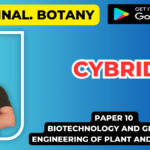![]()
Identification of hybrid (cell) plants
- The development of hybrid cells followed by the generation of hybrid plants requires a clear proof of genetic contribution from both the parental protoplasts.
- The hybridity must be established only from euploid and not from aneuploid hybrids,
- Some of the commonly used approaches for the identification of hybrid plants are as follows
Morphology of hybrid plants
- Morphological features of hybrid plants which usually are intermediate between two parents can be identified.
- For this purpose the vegetative and floral characters are considered, flower shape, its structure, size and colour and seed capsule morphology.
- The somatic hybrid such as pomatoes and topatoes which are fused products of potato and tomato show abnormal morphology, and thus can be identified.
- Although the genetic basis of the morphological characters has not been clearly known, intermediate morphological features suggest that the traits are under the control of multiple genes.
- It is preferable to support hybrid morphological characters with evidence of genetic data.
Isoenzyme analysis of hybrid plants
- The multiple forms of an enzyme catalysing the same reaction are referred to as
- Electrophoretic patterns of isoenzymes have been widely used to verify hybridity.
- Somatic hybrids possess specific isoenzyme of one or the other parent or both parents simultaneously.
- There are many enzymes possessing unique isoenzymes that can be used for the identification of somatic hybrid, e.g. amylase, esterase, aspartate aminotransferase, phosphodiesterase, isoperoxidase and hydrogenase (of alcohol, lactate, malate).
- If the enzyme is dimeric (having two subunits), somatic hybrids usually contain an isoenzyme with an intermediate mobility properties.
- The isozymes are often variable within the same plant. Therefore, it is necessary to use the same enzyme from each plant (parents and somatic hybrids) from a specific tissue with the same age.
Chromosomal constitution.
- The number of chromosomes present in the hybrid cells can be directly counted.
- This provides information on the ploidy state of the cells.
- The somatic hybrid are expected to possess chromosomes that are equal to the total number of chromosomes originally present in the parental protoplasts.
- Sometimes the hybrids are found to contain more chromosomes than the total of both the parents.
- The presence of chromosomal markers is greatly useful for the genetic analysis of hybrid cells.
Molecular techniques
There are numerous techniques which are utilized for the understanding of genetic constituent of the somatic plant hybrids e.g.
- Differences in the restriction patterns of Chloroplast and mitochondrial DNA’s
- Molecular markers such as RFLP, AFLF, RAPD and
- PCR
Chromosome number in somatic hybrids
- The chromosome number in somatic hybrid are more than the total number of both of parental protoplasts.
- So the various variations occur which may be due to the following reasons.
- Fusion of more than two protoplasts.
- Irregularities in mitotic cell divisions.
- In fusogen or electro-induced fusion about one third of the fusions occur between more than two protoplasts.
- Differences on the status of protoplasts (actively dividing or quiescent) from the two species of plants result in formation of asymmetric hybrids.
- Asymmetric hybrid may be due to unequal replication of DNA in the fusing protoplasts.
- Protoplast isolation and culture may also lead to somaclonal variations, and thus variations in chromosome number.
E.g. Table.
| Plant spp with their chromosome number | Chromosome numbers in hybrid |
| Petunia parodi (2n=48)+P.hybrida (2n=14) | 44-48 |
| Datura innoxia (2n=24)+D.stramonium (2n=24) | 46, 48, 72 |
| Nicotiana tobacum (2n =48) N.nesophila (2n=48) | 96 |
Symmetric and asymmetric hybrid
- If the chromosome number in the hybrid is the sum of the chromosomes of the two parental protoplasts the hybrid is said to be symmetric.
- Symmetric hybrid between incompatible species are usually sterile.
- This may be due to production of 3n hybrid by fusion 2n of one species with n of another species.
- Asymmetric hybrid have abnormal or wide variation in the chromosome number than the exact total of two species.
- These hybrids are usually formated with full somatic complement of one parental species while all or nearly all of the chromosomes of other parental species are lost during mitotic division.
- Asymmetric hybrids may be regarded as cybrid but for the introgressed genes.
If protoplast fusion between N.tobacum (2n=48) and N. nesophila (2n =24) result in a symmetric hybrids while asymmetric hybrid are formed when Brassica.napus (2n =38) and B.juncea (2n=36) are fused.













